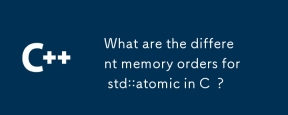 Backend Development
Backend Development C++
C++ How to Set Up OpenCV 2.4 and MinGW for Computer Vision Projects on Windows 7?
How to Set Up OpenCV 2.4 and MinGW for Computer Vision Projects on Windows 7?How to Set Up OpenCV 2.4 and MinGW for Computer Vision Projects on Windows 7?

Getting Started with OpenCV 2.4 and MinGW on Windows 7
OpenCV (Open Computer Vision) is a powerful open-source library focused on real-time computer vision. It's widely used for image processing, computer graphics, motion detection, facial recognition, and more. MinGW (Minimalist GNU for Windows) is a lightweight port of the GNU toolchain for Windows, providing a native Windows environment to compile and run your C and C code. This guide will take you through the steps of installing OpenCV 2.4 and setting up your development environment with MinGW.
1. Installing OpenCV 2.4.3
Begin by downloading OpenCV 2.4.3 from sourceforge.net. Execute the self-extracting file to install OpenCV in a designated directory, such as "C:". Upon completion, you'll find a new "C:opencv" directory containing OpenCV headers, libraries, and samples.
Next, add "C:opencvbuildx86mingwbin" to your system PATH to access OpenCV DLLs required for running your code. Open Control Panel > System > Advanced system settings > Advanced Tab > Environment variables...
In the System Variables section, select "Path", click "Edit...", add "C:opencvbuildx86mingwbin", and click "Ok".
2. Installing MinGW Compiler Suite
For compiling code, gcc (GNU Compiler Collection) is highly recommended. MinGW provides a native Windows port for gcc. Download the MinGW installer from Sourceforge.net and install it in a directory, such as "C:MinGW". Choose to install both "C Compiler" and "C Compiler".
Upon completion, add "C:MinGWbin" to your system PATH as described earlier. To verify the installation, open a command-line box and type "gcc". A successful installation will display an error message: "gcc: fatal error: no input files compilation terminated".
3. Writing a Sample Code
Create a new file named "loadimg.cpp" with the following code:
#include "opencv2/highgui/highgui.hpp"
#include <iostream>
using namespace cv;
using namespace std;
int main(int argc, char** argv)
{
Mat im = imread(argc == 2 ? argv[1] : "lena.jpg", 1);
if (im.empty())
{
cout <p>Place an image file, such as "lena.jpg", in the same directory as the code. Compile the code using the following command:</p>
<pre class="brush:php;toolbar:false">g++ -I"C:\opencv\build\include" -L"C:\opencv\build\x86\mingw\lib" loadimg.cpp -lopencv_core243 -lopencv_highgui243 -o loadimg
After successful compilation, run "loadimg.exe" to display the loaded image.
4. Next Steps
Your OpenCV environment is now ready. Explore the code samples provided in the "C:opencvsamplescpp" directory to gain a deeper understanding of OpenCV's capabilities. Alternatively, you can begin developing your own computer vision applications.
The above is the detailed content of How to Set Up OpenCV 2.4 and MinGW for Computer Vision Projects on Windows 7?. For more information, please follow other related articles on the PHP Chinese website!
 What are the different memory orders for std::atomic in C ?Aug 08, 2025 pm 04:55 PM
What are the different memory orders for std::atomic in C ?Aug 08, 2025 pm 04:55 PMstd::memory_order_relaxedprovidesonlyatomicitywithnosynchronization,usedforcounters;2.std::memory_order_acquireensuressubsequentreadsarenotreorderedbeforetheload,usedwhenreadingreadyflags;3.std::memory_order_releaseensurespriorwritesarenotreorderedaf
 C atomic integer exampleAug 08, 2025 pm 03:30 PM
C atomic integer exampleAug 08, 2025 pm 03:30 PMUse std::atomic to achieve thread-safe shared counters without mutex locks. 1. Declare std::atomiccounter(0) to ensure the atomicity of all operations; 2. Multiple threads call counter.fetch_add(1, std::memory_order_relaxed) to safely increase; 3. The final result is equal to the expected sum, proving that there is no data competition; 4. Applicable to simple operations of univariate to avoid locking overhead, but is not suitable for scenarios where multiple variables need to be synchronized. This method is efficient and concise, suitable for basic concurrent counting needs.
 What are the best practices for C exception handling?Aug 08, 2025 pm 03:23 PM
What are the best practices for C exception handling?Aug 08, 2025 pm 03:23 PMUseexceptionsonlyforexceptionalconditions,notcontrolflow;2.Throwbyvalue,catchbyconstreferencetopreventslicingandcopying;3.Preferstandardexceptionsorderivefromstd::exceptionforcompatibility;4.UseRAIIforautomaticresourcemanagementtopreventleaksduringex
 C adapter pattern exampleAug 08, 2025 pm 03:18 PM
C adapter pattern exampleAug 08, 2025 pm 03:18 PMThe adapter mode is used to convert the interface of one class into another interface expected by the client, so that the originally incompatible classes can work together. 1. The target interface (AudioPlayer) defines the playWav method expected by the client; 2. The adapter (OldPlayer) provides the playMp3 function but the interface is incompatible; 3. The adapter (OldPlayerAdapter) inherits AudioPlayer and combines OldPlayer instances to convert WAV requests to MP3 calls; it is recommended to use object adapters to achieve loose coupling through combination, which is suitable for integrating old systems or third-party libraries, but should not be used when interfaces are compatible, performance sensitive or there are fewer classes. This mode effectively bridges old and new code.
 What is SFINAE and how does it work in C templates?Aug 08, 2025 pm 03:12 PM
What is SFINAE and how does it work in C templates?Aug 08, 2025 pm 03:12 PMSFINAEallowsinvalidtemplatesubstitutionstobesilentlydiscardedratherthancausingcompilationerrors,enablingflexiblecompile-timetypeintrospection;1)whentemplateargumentsubstitutionfails,thecompilerremovesthatcandidateinsteadofraisinganerror;2)thisenables
 C std::next_permutation exampleAug 08, 2025 pm 02:53 PM
C std::next_permutation exampleAug 08, 2025 pm 02:53 PMstd::next_permutation is a function in C used to generate the next dictionary order arrangement. 1. If the current arrangement is not the maximum dictionary order, it will return true and generate the next permutation; 2. If it is already the maximum permutation, it will return false and reset to the minimum dictionary order arrangement; 3. Before use, it is necessary to ensure that the sequence is ascending to traverse all permutations; 4. It can process iterable objects such as arrays and strings; 5. Support custom comparison functions; 6. Automatically derepeat the duplicate elements to generate unique permutations; 7. It is often used in scenarios such as full permutations, enumeration combinations, etc., but the original sequence will be modified and backup needs to be done in advance. This function is efficient and practical, and is suitable for algorithm competition and combinatorial logic.
 C multiset exampleAug 08, 2025 pm 02:51 PM
C multiset exampleAug 08, 2025 pm 02:51 PMThe multiset in C allows the storage of duplicate elements and automatically sorting, with the default ascending order. 1.insert() inserts elements and sorts them automatically; 2.find() returns the first iterator of the matching element; 3.count() counts the number of occurrences of a certain value; 4.erase(value) deletes all elements equal to this value; 5.erase(iterator) deletes only elements at the specified position; 6. Elements are output in an orderly manner during traversal; 7. Descending order arrangement can be specified through greater; suitable for scenarios that need to be ordered and repetitive, such as fraction statistics and timestamp management, and the operation time complexity is O(logn).
 How to implement a thread-safe singleton in C ?Aug 08, 2025 pm 02:37 PM
How to implement a thread-safe singleton in C ?Aug 08, 2025 pm 02:37 PMMeyer'sSingletonisthebestchoiceforC 11 becauseitensuresthread-safe,lazyinitializationusingstaticlocalvariableswithoutexplicitlocks;2.std::call_oncewithstd::once_flagisanalternativewhendynamicallocationorcomplexinitializationisneeded,guaranteeingone-


Hot AI Tools

Undress AI Tool
Undress images for free

Undresser.AI Undress
AI-powered app for creating realistic nude photos

AI Clothes Remover
Online AI tool for removing clothes from photos.

Clothoff.io
AI clothes remover

Video Face Swap
Swap faces in any video effortlessly with our completely free AI face swap tool!

Hot Article

Hot Tools

SecLists
SecLists is the ultimate security tester's companion. It is a collection of various types of lists that are frequently used during security assessments, all in one place. SecLists helps make security testing more efficient and productive by conveniently providing all the lists a security tester might need. List types include usernames, passwords, URLs, fuzzing payloads, sensitive data patterns, web shells, and more. The tester can simply pull this repository onto a new test machine and he will have access to every type of list he needs.

DVWA
Damn Vulnerable Web App (DVWA) is a PHP/MySQL web application that is very vulnerable. Its main goals are to be an aid for security professionals to test their skills and tools in a legal environment, to help web developers better understand the process of securing web applications, and to help teachers/students teach/learn in a classroom environment Web application security. The goal of DVWA is to practice some of the most common web vulnerabilities through a simple and straightforward interface, with varying degrees of difficulty. Please note that this software

Zend Studio 13.0.1
Powerful PHP integrated development environment

EditPlus Chinese cracked version
Small size, syntax highlighting, does not support code prompt function

WebStorm Mac version
Useful JavaScript development tools





